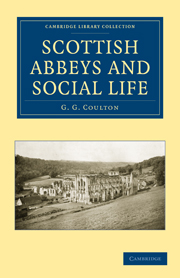Book contents
- Frontmatter
- Contents
- LIST OF ILLUSTRATIONS
- Preface
- Chapter I Celtic Monachism
- Chapter II The Monastic Rules
- Chapter III Monastic Revenues
- Chapter IV How Endowments Came (I)
- Chapter V How Endowments Came (II)
- Chapter VI Monks and Parishes (I)
- Chapter VII Monks and Parishes (II)
- Chapter VIII Charity (I)
- Chapter IX Charity (II)
- Chapter X Monk and Peasant (I)
- Chapter XI Monk and Peasant (II)
- Chapter XII Monastic Housekeeping
- Chapter XIII Church and Scriptorium
- Chapter XIV The Monastic Chronicler
- Chapter XV Schools
- Chapter XVI Art and Learning
- Chapter XVII Professions and Business
- Chapter XVIII Visitation (I)
- Chapter XIX Visitation (II)
- Chapter XX A Voice from the Cloister
- Chapter XXI Conclusion
- Appendixes
- List of Authorities
- Index
Chapter IV - How Endowments Came (I)
Published online by Cambridge University Press: 05 August 2011
- Frontmatter
- Contents
- LIST OF ILLUSTRATIONS
- Preface
- Chapter I Celtic Monachism
- Chapter II The Monastic Rules
- Chapter III Monastic Revenues
- Chapter IV How Endowments Came (I)
- Chapter V How Endowments Came (II)
- Chapter VI Monks and Parishes (I)
- Chapter VII Monks and Parishes (II)
- Chapter VIII Charity (I)
- Chapter IX Charity (II)
- Chapter X Monk and Peasant (I)
- Chapter XI Monk and Peasant (II)
- Chapter XII Monastic Housekeeping
- Chapter XIII Church and Scriptorium
- Chapter XIV The Monastic Chronicler
- Chapter XV Schools
- Chapter XVI Art and Learning
- Chapter XVII Professions and Business
- Chapter XVIII Visitation (I)
- Chapter XIX Visitation (II)
- Chapter XX A Voice from the Cloister
- Chapter XXI Conclusion
- Appendixes
- List of Authorities
- Index
Summary
When once the monks had settled down from missionary conditions into the position of great landlords, they inevitably took something of the colour of a squirearchy. They had dovecotes and mills and all other monopolies of a privileged landed aristocracy. The greater abbeys even had regalities; that is, all royal rights except those which were of definite political importance. Among these were the right of hanging or drowning criminals and taking their forfeited property; Kelso had this, with Arbroath, Melrose, Balmerino, Scone and Paisley. At Paisley, the name Gallowhill still survives; and there was an island in the Tay where, as a twelfth-century record tells us, “judicial duels were fought concerning Scone”: that is, the monks had the right of defending their claims by the body of a professional champion. We have an interesting case of this kind from the diocese of York in 1239. It was reported to the pope that the monks of Mont-St-Michel in Normandy had possessed
the manor of Wat…and they have always had two monks on the manor, but Robert Marmion, knight, of the diocese of York, claimed the manor in right of his wife, and the predecessor of the present abbot was summoned before the king's court, where the said knight offered to prove by duel that the manor was his; which challenge, although he had other defence, the late abbot indiscreetly accepted. […]
- Type
- Chapter
- Information
- Scottish Abbeys and Social Life , pp. 53 - 67Publisher: Cambridge University PressPrint publication year: 2010First published in: 1933

